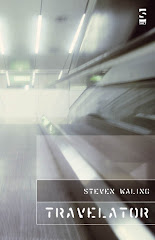Geraldine Monk is one of those poets who one gets the feeling would be much wider known, if only she weren't one of those darned "other poets" who get left out of the lists when it comes to official verse culture. She is funny, wise and playful, and she probably has as much understanding of the physicality of language as any poet living in this country. In this book, as in many of her other books, sound and meaning clash and merge, dance around each other like two lovers still working each other out.
Her poems are often difficult to quote from in a blog review, because she places words very carefully on the page to emphasise their relationship and to add a visual dimension to her poems. This is often called "open form" or "projective verse", and is where we see the influence of Olson and the Black Mountain poets; but hers is also a profoundly local as well as international poetry.
In Poppyheads, for instance, she takes her inspiration from the carved at the end of pews in a church in Rotherham, not far from her home in Sheffield. These short verses evoke both the carvings and the natural magic of the North of England:
I
float
to the
edge of my pond -
flutters bug me. Litter. Water louse.
Damsels in. Nothing is for ever. Floozies
ply. So long dragons - fly now nymphs.
I see dragonflies over a river or a millpond, and I hear them too, in the alliteration, in the rhythm that dashes about. Throughout her work, there is this reaching out for a language that doesn't just explain or evoke the world, but reaches into it and brings it to life for us.
This book, in some ways, is a gathering together of various pieces rather than a fully unified collection, which her last, the sonnet sequence Ghosts & Other was. Nevertheless, the sequences do hold together and explore the mysterious edge of the natural world. She even manages, in Glow in the Darklunar Calendar to reinvigorate that old standby of poets, the moon. Though I'm always aware of Mina Loy's line from The Lunar Baedecker, about that familiar symbol of mystery "pockmarked with personification", she manages to range widely between the scientific, the mythic and the mystical in often beautiful lines that show there is life in the old satellite yet.
Perhaps not her most essential read: for that I recommend Interegnum and Escafedd Hangings; but this is nevertheless a very enjoyable book. It brings together sequences that add further to our understanding of one of the best poets, and really should be enjoyed much wider than she is. And I do say enjoyed: the gusto of these poems, the linguistic play and the brio of the dancing words is not something to be worried over. They should be read quickly first, to get the music of them, and then savoured, read aloud. She wants you to join in the dance.
